Abstract
A community was exposed for several days to formaldehyde (HCHO), hexamethylenetetramine, trimethylamine, and paraformaldehyde emitted from an overheated tanker car containing ureaformaldehyde resin. Residents experienced acute HCHO symptoms at the time of the accident. Many developed chronic, multiple organ health complaints. Three years following the accident, exposed subjects were compared to residents of a nearby unexposed community for the following immunological parameters: white blood cell count, total lymphocyte count, percent and total lymphocyte subsets (CD5, CD4, CD8, CD19, CD25, and CD26 cells), prevalence of autoantibodies, and antibodies to HCHO-human serum albumin (HCHO-HSA) conjugate. The data were adjusted for gender, age, history of smoking, mobile home residency, and use of wood stoves. There was a statistically significant difference for the following: elevated percent and absolute numbers of CD26 cells (p less than 0.0001); autoantibodies (p less than 0.004), and greater titers of isotypes IgG (p less than 0.0005) and IgM (p less than 0.005) to HCHO-HSA. It is concluded that the exposed subjects had an activated immune system in addition to the elevated autoantibodies. Also, isotypes to HCHO-HSA resulted from the exposure and no other sources, such as smoking, mobile home residency, and use of wood stoves.
Full text
PDF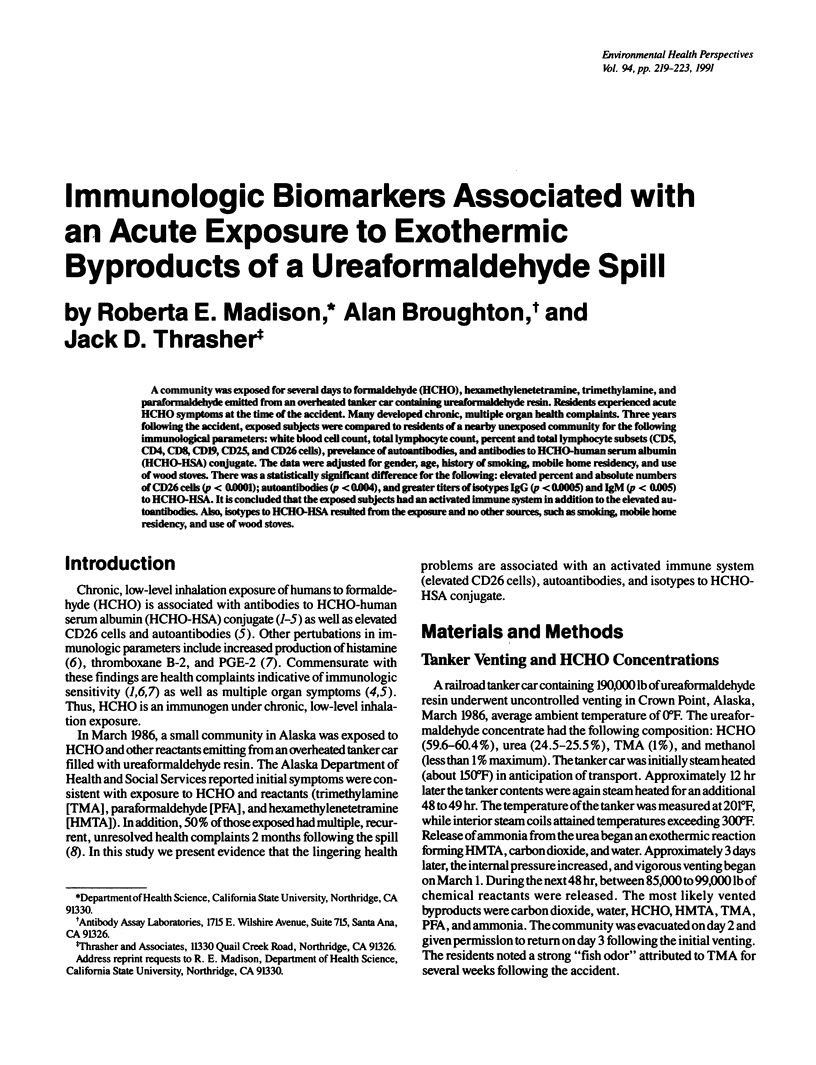
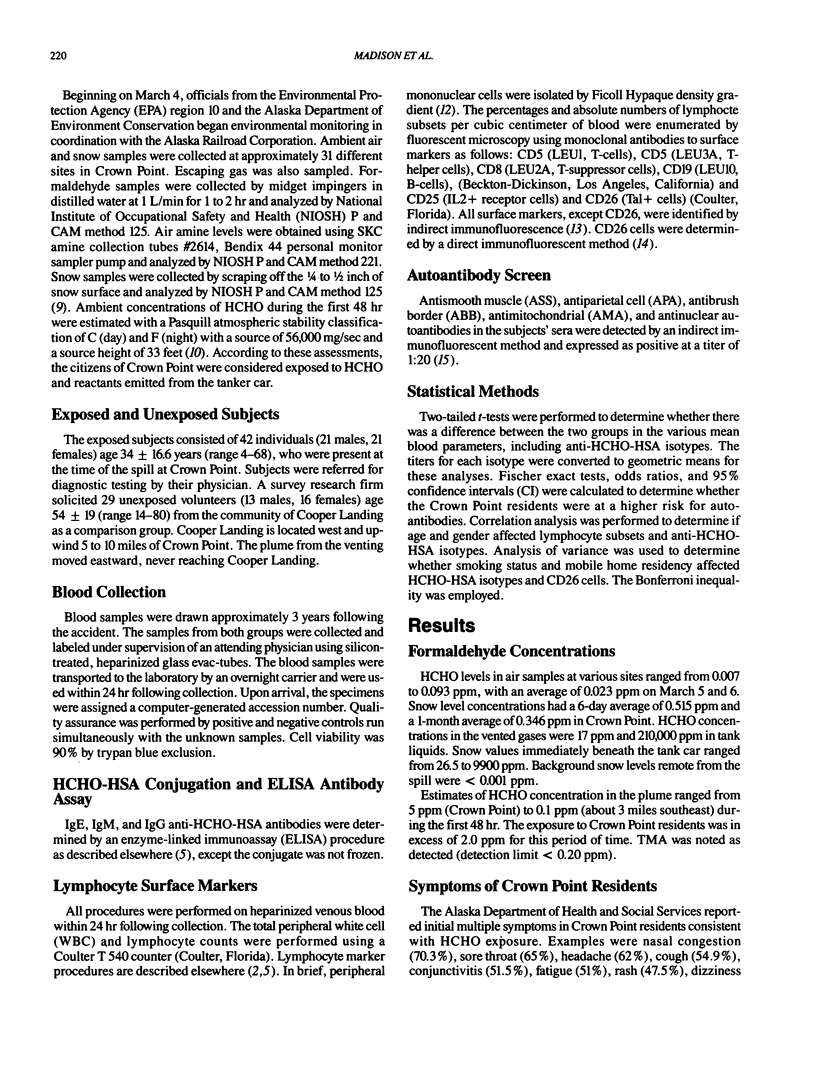
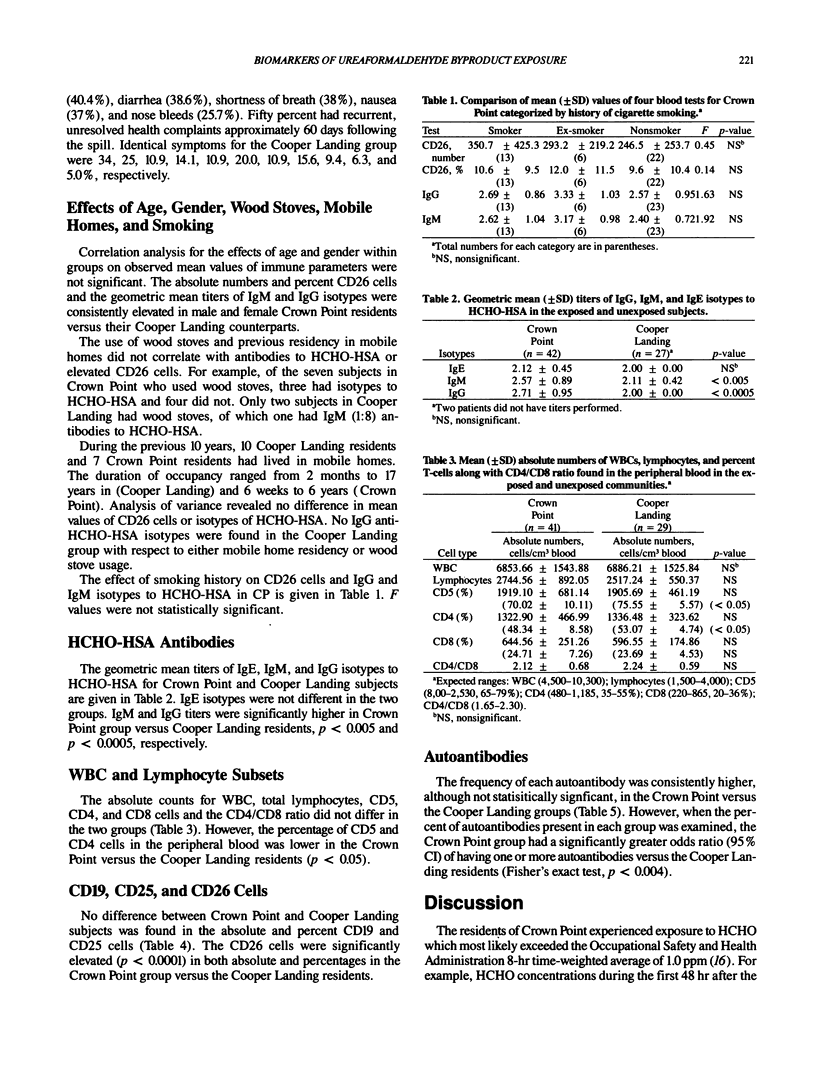
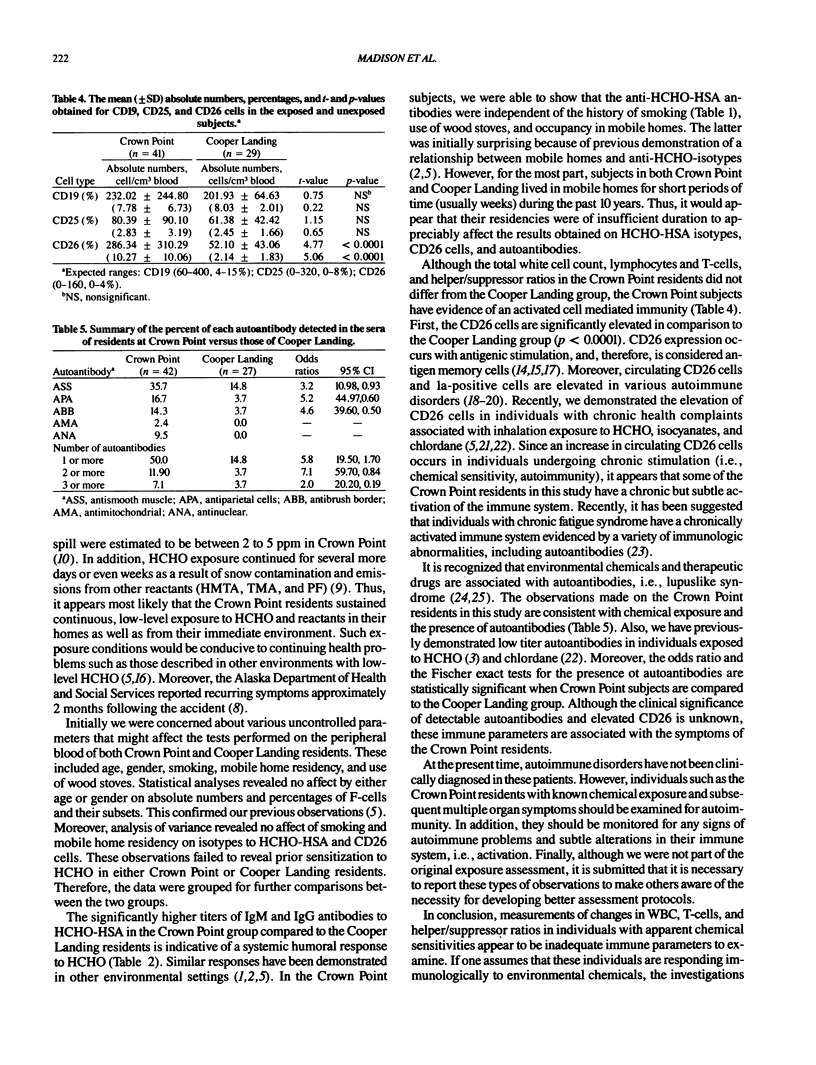
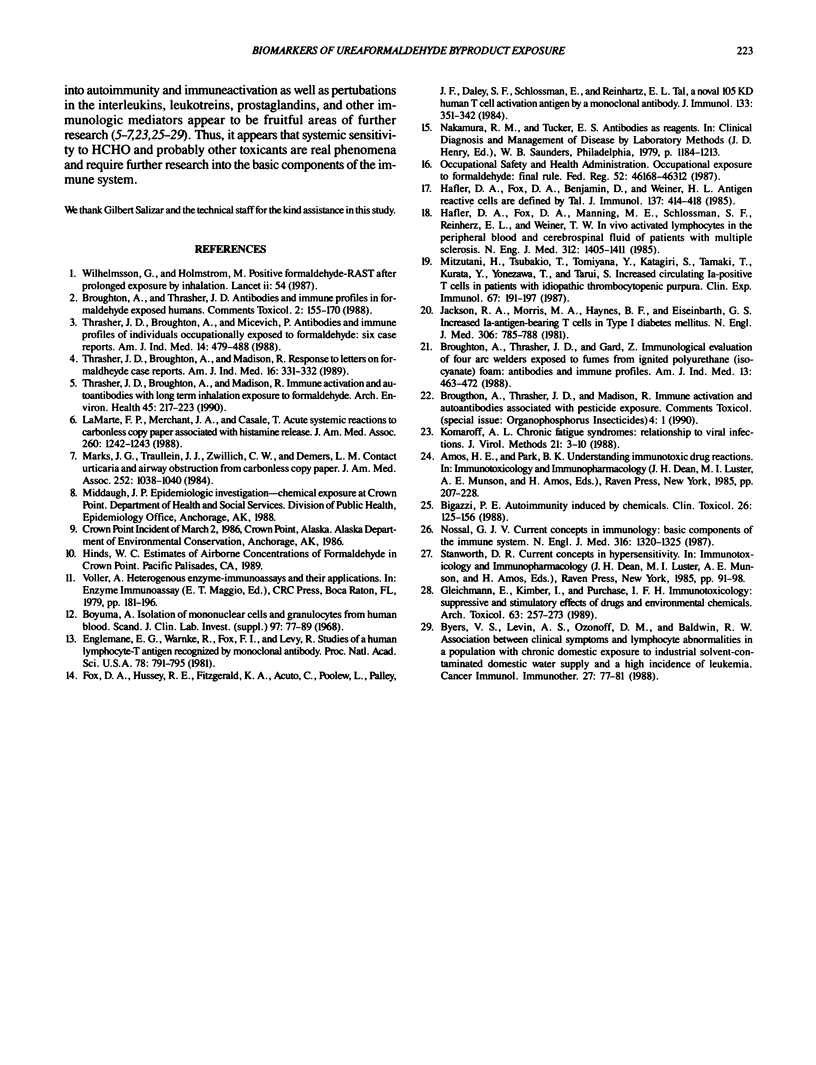
Selected References
These references are in PubMed. This may not be the complete list of references from this article.
- Beavers J. D. Formaldehyde exposure reports. Am J Ind Med. 1989;16(3):331–336. doi: 10.1002/ajim.4700160312. [DOI] [PubMed] [Google Scholar]
- Bigazzi P. E. Autoimmunity induced by chemicals. J Toxicol Clin Toxicol. 1988;26(3-4):125–156. doi: 10.3109/15563658809000343. [DOI] [PubMed] [Google Scholar]
- Broughton A., Thrasher J. D., Gard Z. Immunological evaluation of four arc welders exposed to fumes from ignited polyurethane (isocyanate) foam: antibodies and immune profiles. Am J Ind Med. 1988;13(4):463–472. doi: 10.1002/ajim.4700130406. [DOI] [PubMed] [Google Scholar]
- Byers V. S., Levin A. S., Ozonoff D. M., Baldwin R. W. Association between clinical symptoms and lymphocyte abnormalities in a population with chronic domestic exposure to industrial solvent-contaminated domestic water supply and a high incidence of leukaemia. Cancer Immunol Immunother. 1988;27(1):77–81. doi: 10.1007/BF00205762. [DOI] [PMC free article] [PubMed] [Google Scholar]
- Böyum A. Isolation of mononuclear cells and granulocytes from human blood. Isolation of monuclear cells by one centrifugation, and of granulocytes by combining centrifugation and sedimentation at 1 g. Scand J Clin Lab Invest Suppl. 1968;97:77–89. [PubMed] [Google Scholar]
- Gleichmann E., Kimber I., Purchase I. F. Immunotoxicology: suppressive and stimulatory effects of drugs and environmental chemicals on the immune system. A discussion. Arch Toxicol. 1989;63(4):257–273. doi: 10.1007/BF00278639. [DOI] [PubMed] [Google Scholar]
- Hafler D. A., Fox D. A., Benjamin D., Weiner H. L. Antigen reactive memory T cells are defined by Ta1. J Immunol. 1986 Jul 15;137(2):414–418. [PubMed] [Google Scholar]
- Hafler D. A., Fox D. A., Manning M. E., Schlossman S. F., Reinherz E. L., Weiner H. L. In vivo activated T lymphocytes in the peripheral blood and cerebrospinal fluid of patients with multiple sclerosis. N Engl J Med. 1985 May 30;312(22):1405–1411. doi: 10.1056/NEJM198505303122201. [DOI] [PubMed] [Google Scholar]
- Jackson R. A., Morris M. A., Haynes B. F., Eisenbarth G. S. Increased circulating Ia-antigen-bearing T cells in type I diabetes mellitus. N Engl J Med. 1982 Apr 1;306(13):785–788. doi: 10.1056/NEJM198204013061305. [DOI] [PubMed] [Google Scholar]
- Komaroff A. L. Chronic fatigue syndromes: relationship to chronic viral infections. J Virol Methods. 1988 Sep;21(1-4):3–10. doi: 10.1016/0166-0934(88)90047-x. [DOI] [PubMed] [Google Scholar]
- Marks J. G., Jr, Trautlein J. J., Zwillich C. W., Demers L. M. Contact urticaria and airway obstruction from carbonless copy paper. JAMA. 1984 Aug 24;252(8):1038–1040. [PubMed] [Google Scholar]
- Mizutani H., Tsubakio T., Tomiyama Y., Katagiri S., Tamaki T., Kurata Y., Yonezawa T., Tarui S. Increased circulating Ia-positive T cells in patients with idiopathic thrombocytopenic purpura. Clin Exp Immunol. 1987 Jan;67(1):191–197. [PMC free article] [PubMed] [Google Scholar]
- Nossal G. J. Current concepts: immunology. The basic components of the immune system. N Engl J Med. 1987 May 21;316(21):1320–1325. doi: 10.1056/NEJM198705213162107. [DOI] [PubMed] [Google Scholar]
- Thrasher J. D., Broughton A., Madison R. Immune activation and autoantibodies in humans with long-term inhalation exposure to formaldehyde. Arch Environ Health. 1990 Jul-Aug;45(4):217–223. doi: 10.1080/00039896.1990.9940805. [DOI] [PubMed] [Google Scholar]
- Thrasher J. D., Broughton A., Micevich P. Antibodies and immune profiles of individuals occupationally exposed to formaldehyde: six case reports. Am J Ind Med. 1988;14(4):479–488. doi: 10.1002/ajim.4700140411. [DOI] [PubMed] [Google Scholar]
- Weeks R. S., Mains P. E., Sibley C. H. Comparison of membrane IgM expression in the murine B cell lymphoma 70Z/3 treated with LPS or supernatant containing T cell factors. J Immunol. 1984 Jul;133(1):351–358. [PubMed] [Google Scholar]


